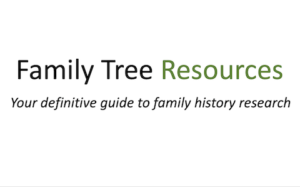A Genealogy Research Log is used to help you to write down what sources you have accessed and why you wish to research those sources. You can also write down what information you wish to find, and how it can help your family history research. Maybe you have an aim to break down a genealogy brick wall or find a particular ancestor’s parents. Whatever your aim, be sure to write it down.
This will save you valuable time in a Record Office because you do not have to spend time researching what sources you wish to access. Having a research log may make it possible to order documents before your visit, which helps you save valuable time.
What is a Genealogy Research Log Used For?
A research log is where you can note down what you are looking for, what sources you have looked at, and what information you have uncovered.
You can use it to create a detailed list of sources you have accessed, where the source(s) is located, any findings, and comments about your research such as writing down all the information you have uncovered in your research, and if you have needed to do anything special in your search such as using a wildcard search if searching on a computer.
If you have to take a long break from your genealogy research, the log will help to remind you of the research you have already undertaken. You do not then have to repeat searches you have already conducted when you are next able to conduct research.
Although you may wish to only write down what information you have uncovered, it is equally important, if not more so, to write down the sources you have accessed where you did NOT find the information you were seeking. This will help future research because you already know that you have not found the relevant information in that source. This will save you from accessing this source again in the future.
You can also write down any questions your research has created. For instance, I found in the 1851 Census for Roade, Northamptonshire, that the Dunkley family were indeed present in this source:
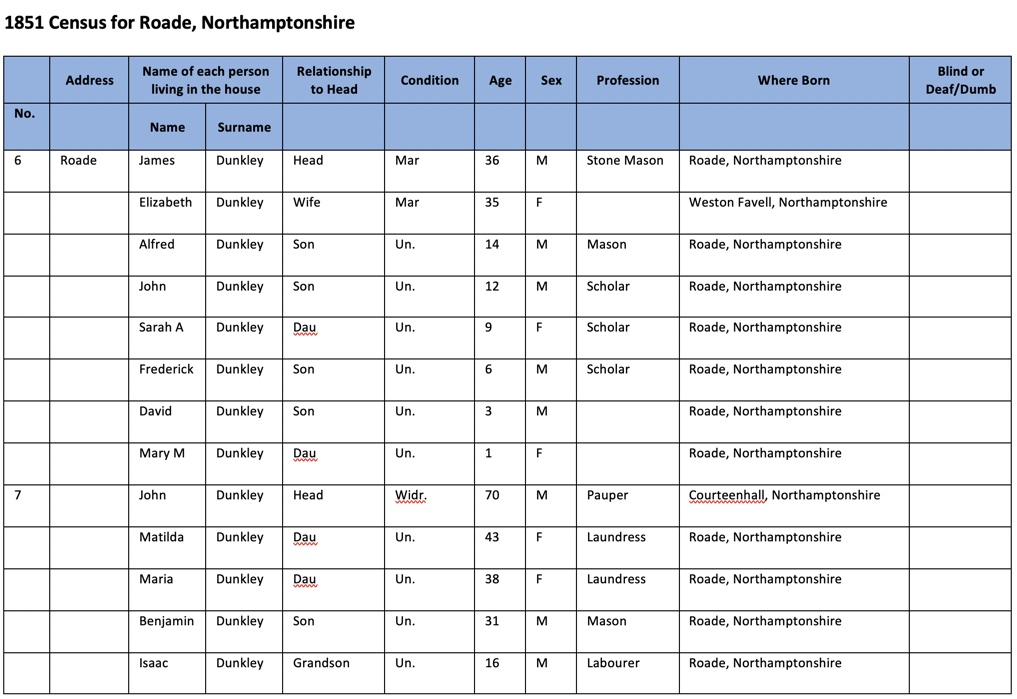
Further Questions to Add to The Log
I entered the fact that I had found the Dunkley family on the 1851 Census into my Research Log. Although I had found the information, it actually left me with more questions such as:
- Why were the Dunkley’s living next door to each other?
- What was James’s relationship to John?
- What was Elizabeth’s (wife of James) maiden name?
- Could I find James and Elizabeth’s children in the baptism register?
- Who was John’s wife?
- When did John’s wife die?
- Who were Isaac’s parents?
As you can see, even finding information left me with many more questions, which I noted down.
What Information Should be Included in a Research Log?
- Name of person you are seeking
If, as per the questions above, you decide you want to focus on finding out who Isaac Dunkley’s parents were, you should put his name down as the person you are seeking.
If you have searched through many different spellings of a surname, such as Dun*ley, Dunc*ley etc, you could enter this here too so that you know what different spellings you have tried so you can easily find the information again if you need to. Should you not find any information, this makes it easier to discover what alternative spellings of the surname you could try. - Date you conducted the search
You should include the date you conducted the research. This is crucial because it will help you in the future if you do not find the information. If you write down the date, you can always search in that record again. Online databases and indexes are being updated all the time.
The information you are seeking may be added to the record at a later date, so making a note of the date is crucial. Other reason you may not be able to find the information is that it may have been transcribed incorrectly. Someone else may later add an amendment to the record, making it possible for you to find the information.
For example, when I originally searched in the 1851 Census for Isaac Dunkley, I could not find him. I later found out that his name had been incorrectly transcribed in Ancestry’s index as Bunkley. - Research Question
This is what you wish to discover, so this is where you enter the question as described above – who were Isaac Dunkley’s parents? If you have more than one research question, you can add more questions as you think of them.
This is better than having a different sheet for every question as I am sure you will find many more. As my next question was related to where Isaac was in 1861, I added that question to the log. - Place of Research
This is where you write down the place of your search. As the 1851 Census stated Isaac was born in Roade, Northamptonshire, this is what you should enter here. - Description of Source
You should note the source you are looking in here. In this case, I entered that this was the baptism register for Roade, Northamptonshire. - Location of Source
It is also important to make a note of where you found the source. If is a microfilm, you can make a note of the place you found the information, along with the item number in the Record Office or Library. For example, I searched in the baptism register on Ancestry, so I entered Ancestry into this box. - Years of Search
Enter the year(s) you are searching in. I knew from the 1851 Census that Isaac was born in abt. 1835, so I entered 1833-1838 into this box. If he was born in 1835-7, he may have been born before the advent of civil registration in 1837.
If you have an idea of an ancestor’s year of birth, it is prudent to search a few years either side of this date just in case the year of birth is incorrect. Isaac was actually baptised on 25 June 1837. If I only searched in 1836, I would not have found his baptism record. - Information You Have Uncovered (or not) in the Source
You can enter the information you found in the source in this column. For example, I found that Isaac Dunkley was baptised with his brother William on 25 June 1837 in Roade. He and his brother were both illegitimate, being the sons of Maria Dunkley.
If you do not find the information you are seeking, you should write that you have not found any details. If you do not wish to enter the details of any wildcard search etc by your ancestor’s name in the top section, you could also enter information about your search here, such as adding how you have found the record, and if online, whether or not you used a wildcard search.
On this occasion, however, I did not need to conduct the search using any alternative spellings of the surname so I entered that into the record. - Any Other Information
Should you need to find additional information, such as ordering a birth, death or marriage certificate, you would enter this information here along with the cost and when you ordered the certificate.
This will help you to keep to a genealogy budget if you have one. It will also tell you when you can expect to receive the record through the post. For example, if I had looked at the GRO Index to find Isaac’s marriage record, and had found enough information to order a certificate, I would have added the cost to this column, including when I had ordered the certificate.
An Example of this Information:
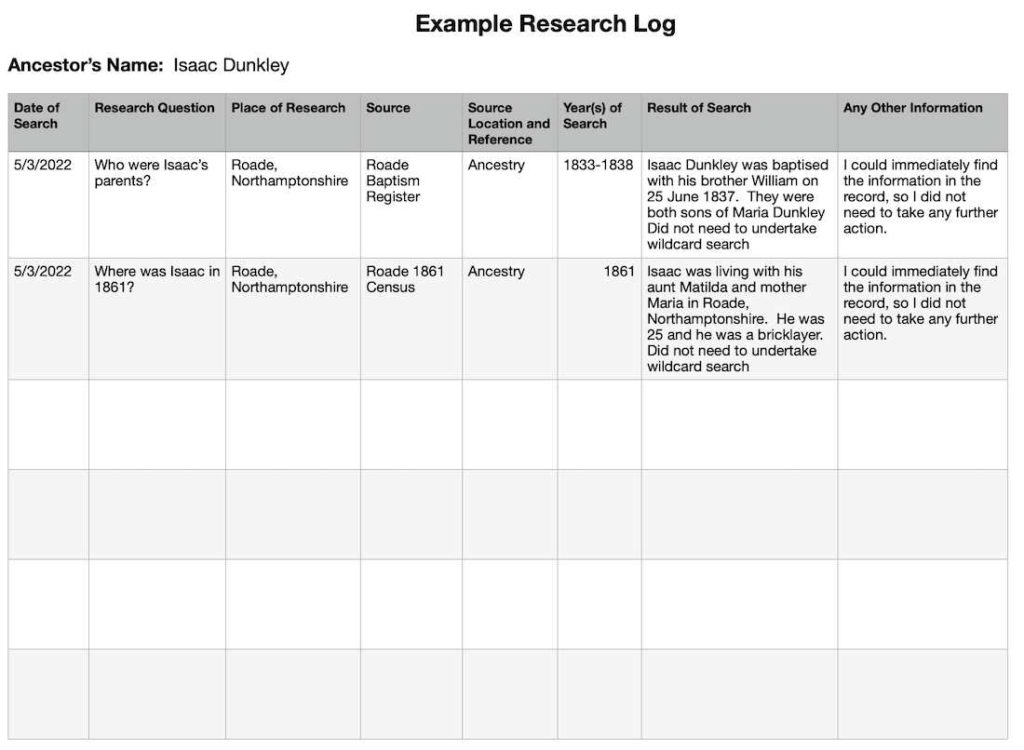
Genealogy Research Log Form
I have designed several different formats of the Research Log to suit everybody’s research needs. If you prefer to fill out forms by hand, it is possible to download and print off the form. If you are conducting research online, but still wish to fill out the log by hand, that is also possible. The choice is yours.
You can also download the log in Microsoft Word or Apple Pages format from this page. I have created a PDF format of the file so that you can edit it on a tablet using a program such as Xodo or on an iPad using a program such as Goodnotes. This will help you to save paper as you can edit the file digitally. If you do choose this method, however, it is very important that you backup your files.
Word Format
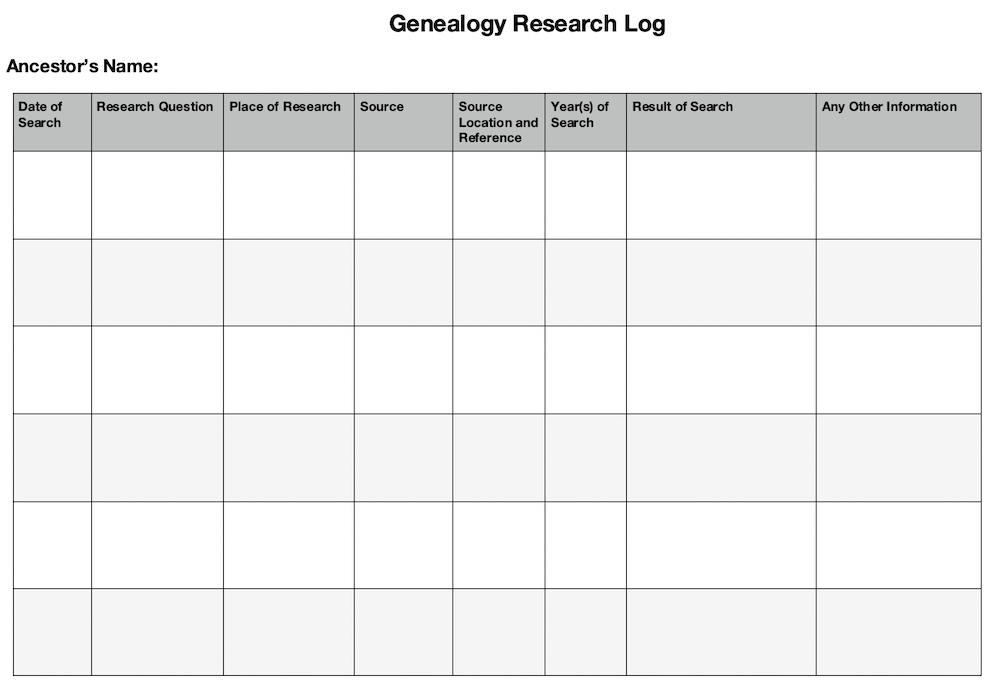
Apple Pages Format
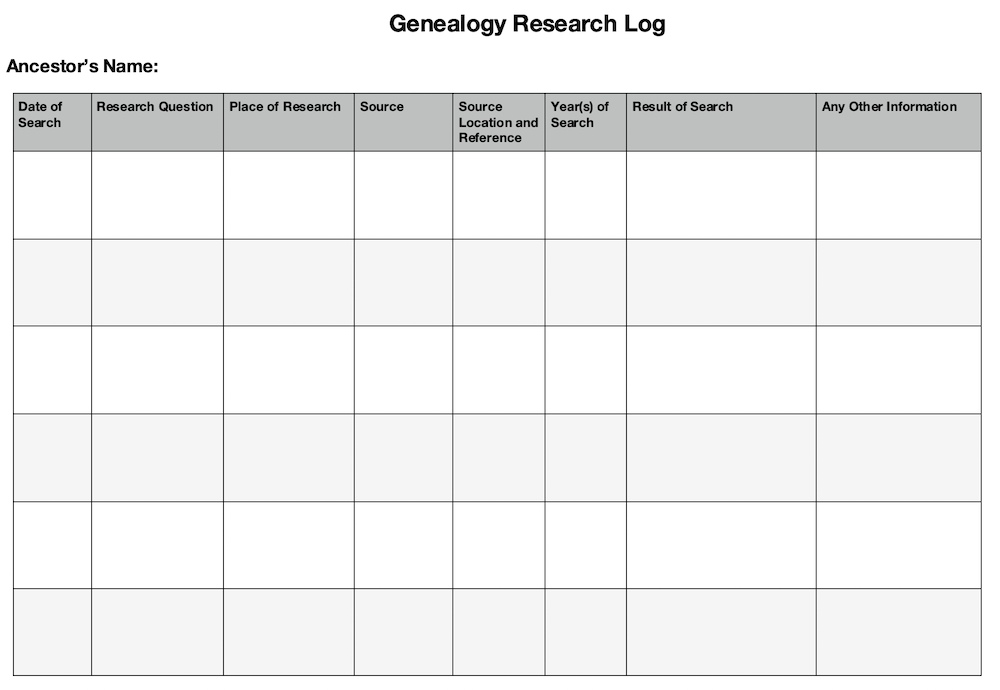
PDF Format

If you wish to download the log in PDF format, you will need to obtain Adobe Acrobat Reader, which is free to download. If you have an iPad, the PDF version of the log can also be exported into Goodnotes. Please be aware that you do have to pay to use Goodnotes. If you have an Android tablet, you can download Xodo PDF reader, which will allow you to edit PDFs. Xodo is free to download.
A video regarding how to use Goodnotes 5 has been made by KDigitalStudio:
A video regarding how to use Xodo has been made by Powerhouse Planners:
Using a Filing System for the Research Logs
Once you have begun conducting your research, and have filled in multiple research logs in whichever way you prefer, you will find that these have to be organised. If you have filled the forms in by hand, you can always file then alphabetically in your binders. That way you can easily find the document again should you ever need to.
It is prudent to take paper versions with you if you visit a Record Office or Library. If something goes wrong with your computer or laptop, you can still use the paper versions.
If you use the electronic version, it may still be prudent to utilise a filling system. You could start with yourself, and add a folder for your parents, moving the other folder into it, and so on. You will then be left with something like this:
Dunkley > Maria Dunkley > Isaac Dunkley > Herbert Dunkley > Frederick Dunkley > Norman Dunkley > Rachel Dunkley
If you use the surname as the main folder name, it is easy to add folders as you find more information. You can then add folders to each person’s file. That way you can easily find the file you are seeking.
If you are yet to discover the surname, such as that for a wife’s maiden name, it may be a good idea to include her details such as where she lived, her age, her place of birth etc., with that of her husband. This makes it easier to find that person rather than having to search through many different Elizabeth’s in your files. Once you have (hopefully!) found her maiden name, you can then easily transfer that file/folder into a new folder.
Importance of Completing a Research Log
It is very important to keep it up-to-date so that you can keep your research organised, and will not forget any sources you have utilised and NOT found the information. If you do not write down that you have already looked at that source, you may forget that you have looked in it, thus wasting valuable research time by looking in the record again, only to come away disappointed.
I cannot stress enough how important it is to write down EVERYTHING you discover in the record you are perusing. If, for instance, you are looking at a marriage record, write down the names of the witnesses – you never know, they may turn out to be relations of the bride or groom, which may help you to ascertain if you have the correct record, especially if you are looking for people with a more common surname. Believe me, the surname you may not think is that common could be very common in the area you are searching in.
If you have found a baptism record, write down the occupation of the father if it is recorded. Again, this may turn out to be very important and could help you to track down the correct family.
Another reason for completing the log is that you can easily share the information you have collected with other people if you wish. If, for example, you and other family members are all researching the family history, keeping a research log will make it easier for you to share what sources you have searched in and what information you have discovered. This will save the other people from searching the same records again.
If you are all researching for the family, it may be prudent to keep a digital research log rather than a paper one so that you can upload the log to the cloud or other online storage and give access to other people so that you can all view and edit the log.
Whether you are a beginner or a more experienced genealogist, the log can be very useful. Although filling in the information takes time and can seem arduous, the time you could end up saving is incalculable.
